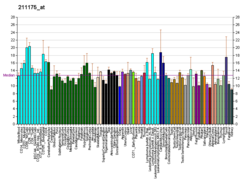
Lysophosphatidic acid receptor 4 also known as LPA4 is a protein that in humans is encoded by the LPAR4 gene. LPA4 is a G protein-coupled receptor that binds the lipid signaling molecule lysophosphatidic acid (LPA).

Probable G-protein coupled receptor 25 is a protein that in humans is encoded by the GPR25 gene.

G-protein coupled receptor 39 is a protein that in humans is encoded by the GPR39 gene.

Putative G-protein coupled receptor 42 is a protein that in humans is encoded by the GPR42P gene.

Sphingosine-1-phosphate receptor 4 also known as S1PR4 is a human gene which encodes a G protein-coupled receptor which binds the lipid signaling molecule sphingosine 1-phosphate (S1P). Hence this receptor is also known as S1P4.

Lysophosphatidic acid receptor 6, also known as LPA6, P2RY5 and GPR87, is a protein that in humans is encoded by the LPAR6 gene. LPA6 is a G protein-coupled receptor that binds the lipid signaling molecule lysophosphatidic acid (LPA).

Prokineticin receptor 1, also known as PKR1, is a human protein encoded by the PROKR1 gene.

Probable G-protein coupled receptor 173 is a protein that in humans is encoded by the GPR173 gene.

Leucine-rich repeat-containing G-protein coupled receptor 4 is a protein that in humans is encoded by the LGR4 gene. LGR4 is known to have a role in the development of the male reproductive tract, eyelids, hair and bone.

Probable G-protein coupled receptor 135 is a protein that in humans is encoded by the GPR135 gene.

Probable G-protein coupled receptor 63 is a protein that in humans is encoded by the GPR63 gene.

Adhesion G-protein coupled receptor A3 (ADGRA3), also known as GPR125, is an adhesion GPCR that in humans is encoded by the Adgra3 gene.

Probable G-protein coupled receptor 133 is a protein that in humans is encoded by the GPR133 gene.

Probable G-protein coupled receptor 85 is a protein that in humans is encoded by the GPR85 gene.

Mas-related G-protein coupled receptor member X3 is a protein that in humans is encoded by the MRGPRX3 gene.

Olfactory receptor 7A5 is a protein that in humans is encoded by the OR7A5 gene.

Olfactory receptor 7C1 is a protein that in humans is encoded by the OR7C1 gene.

Zinc finger protein 161 homolog is a protein that in humans is encoded by the ZFP161 gene.

Proteasome assembly chaperone 1 is a protein that in humans is encoded by the PSMG1 gene.

GPR182 is a human gene which is an orphan G-protein coupled receptor.

















